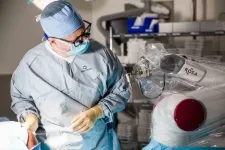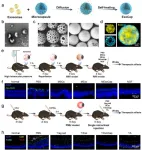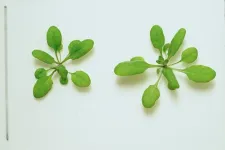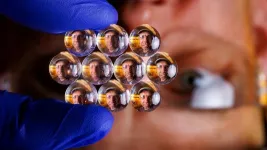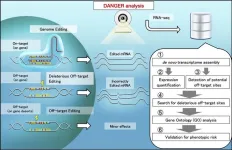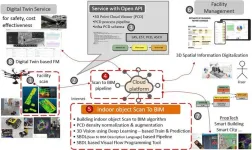Doebel innovating developmental science with an online, scalable meta-science platform for investigating cognitive development during early childhood
2023-10-23
Doebel Innovating Developmental Science With An Online, Scalable Meta-Science Platform For Investigating Cognitive Development During Early Childhood
Sabine Doebel, Assistant Professor, Psychology, received $2,784 from the University of Texas at Dallas on a subaward from the National Science Foundation for: "Subaward Project GARDEN: Innovating Developmental Science with an Online, Scalable Meta-Science Platform for Investigating Cognitive Development During Early Childhood."
Regarding the importance of the project, Doebel said, "Project GARDEN will leverage online methodologies to gather data from a large, ...
Debus-Sherrill receives supplemental funds for elevate academy for juvenile providers
2023-10-23
Debus-Sherrill Receives Supplemental Funds For Elevate Academy For Juvenile Providers
Sara Debus-Sherrill, Senior Research Associate, Center for Advancing Correctional Excellence (ACE!), received $153,424 from County of Alameda for: "Supplemental Funds for Elevate Academy for Juvenile Providers." This funding began in Aug. 2023 and will end in late June 2024.
Debus-Sherrill said, "This project funds the development and delivery of a training academy for community-based organizations providing services to justice-involved youth in Alameda County, California."
###
About George Mason University
George ...
Parsa studying design of joint 3D solid-state learning machines for various cognitive use-cases
2023-10-23
Parsa Studying Design Of Joint 3D Solid-State Learning Machines For Various Cognitive Use-Cases
Maryam Parsa, Assistant Professor, Electrical and Computer Engineering, received funding from the National Science Foundation for the project: "Collaborative Research: NCS-FR: DEJA-VU: Design of Joint 3D Solid-State Learning Machines for Various Cognitive Use-Cases."
In this collaborative project, Parsa joins a team of faculty members from the University of Wisconsin Madison (Dr. Akhilesh Jaiswal), and the University of California Irvine (Dr. Babak Shahbaba and Dr. Norbert ...
New study confirms safety and benefits of maternal COVID-19 vaccination for newborns
2023-10-23
Toronto, ON, October 23, 2023 – Infants of pregnant women who received an mRNA COVID-19 vaccine during pregnancy had lower risks of severe health outcomes, neonatal death, and neonatal intensive care unit (NICU) admission, according to a new study from researchers at ICES and the University of Toronto.
Published in JAMA Pediatrics, the study included more than 140,000 infants in Ontario, and also showed that newborn and six-month readmissions to the NICU did not increase in infants of mothers vaccinated during pregnancy.
"Our results were consistent across the number of doses someone received during pregnancy, the trimester in which they were ...
Newborn and early infant outcomes following maternal COVID-19 vaccination during pregnancy
2023-10-23
About The Study: In this study of 142,000 live births in Ontario, Canada, maternal mRNA COVID-19 vaccination during pregnancy was associated with lower risks of severe neonatal morbidity, neonatal death, and neonatal intensive care unit admission and no increase in neonatal readmission or hospital admission up to age six months, compared with no maternal COVID-19 vaccination before delivery.
Authors: Jeffrey C. Kwong, M.D., M.Sc., of ICES in Toronto, is the corresponding author.
To access the embargoed study: Visit our For The Media website at this link https://media.jamanetwork.com/
(doi:10.1001/jamapediatrics.2023.4499)
Editor’s ...
Prenatal lead exposure, genetic factors, and cognitive developmental delay
2023-10-23
About The Study: In this study of 2,361 mother-child pairs followed up prenatally to child age of approximately two years, prenatal lead exposure was associated with an increased risk of cognitive developmental delay (CDD) in children, especially in those with a high genetic risk. These findings suggest that prenatal lead exposure and genetic background may jointly contribute to an increased risk of CDD for children and indicate the possibility for an integrated strategy to assess CDD risk and improve ...
Researchers use pioneering new method to unlock brain’s noradrenaline system
2023-10-23
An international team of researchers has provided valuable insights into the brain’s noradrenaline (NA) system, which has been a longtime target for medications to treat attention-deficit/hyperactivity disorder, depression, and anxiety.
Equally important beyond the findings is the groundbreaking methodology that the researchers developed to record real-time chemical activity from standard clinical electrodes which are routinely implanted for epilepsy monitoring.
Published online in the journal Current Biology on Monday (Oct. 23), the research not only provides new insights into the brain’s chemistry, which could have implications ...
Scientists develop ‘pseudo cell’ formulation for vitreoretinal disease therapy
2023-10-23
Researchers from the Institute of Process Engineering (IPE) of the Chinese Academy of Sciences and Beijing Chaoyang Hospital have developed a new "pseudo cell" formulation based on self-healing microcapsule-loading exosomes to treat diverse vitreoretinal diseases.
The study was published in Nature Biomedical Engineering on Oct. 23.
Vitreoretinal diseases include a wide spectrum of vision-threatening disorders, which may cause severe irreversible vision loss. The efficacy of current treatments for vitreoretinal diseases in clinic is generally unsatisfactory and treatments often cause several side effects. Moreover, frequently repeated treatments ...
Increased West Antarctic Ice Sheet melting ‘unavoidable’
2023-10-23
Scientists ran simulations on the UK’s national supercomputer to investigate ocean-driven melting of the West Antarctic Ice Sheet: how much is unavoidable and must be adapted to, and how much melting the international community still has control over through reduction of greenhouse gas emissions.
Taking into account climate variability like El Niño, they found no significant difference between mid-range emissions scenarios and the most ambitious targets of the 2015 Paris Agreement. Even under a best-case scenario of 1.5°C global temperature rise, melting will increase three times faster than ...
Novel cause of brain mosaicism and focal epilepsy identified
2023-10-23
(COLUMBUS, Ohio) – In most people, every cell in their body contains the same genetic information. However, sometimes people can have two or more genetically different sets of cells. This usually happens during fetal development and is known as mosaicism. Sometimes one of those groups of cells has genetic changes that can cause diseases or disorders.
Neurologists, neurosurgeons and genomics experts have been working together to test for mosaicism in brain tissues resected during epilepsy surgery. Research has shown that mosaicism in the brain is a significant contributor to epilepsy.
In a new study, recently published in Nature ...
Multitarget stool RNA test for colorectal cancer screening
2023-10-23
About The Study: In a clinical trial that included 8,920 participants, a noninvasive, multitarget stool RNA test (ColoSense) for colorectal cancer screening showed high sensitivity for colorectal neoplasia (colorectal cancer and advanced adenoma) with significant improvement in sensitivity relative to the fecal immunochemical test. Specificity for no lesions on colonoscopy was comparable to existing molecular diagnostic tests.
Authors: Erica K. Barnell, M.D., Ph.D., of the Washington University School of Medicine in St. Louis, is the corresponding author.
To access ...
Plants transformed into detectors of dangerous chemicals
2023-10-23
What if your house plant could tell you your water isn’t safe? Scientists are closer to realizing this vision, having successfully engineered a plant to turn beet red in the presence of a banned, toxic pesticide.
To achieve this, UC Riverside researchers had to solve an engineering puzzle: how to enable a plant to sense and react to a chemical in the environment without damaging its ability to function normally in all other respects.
“The biggest piece here is we’ve created an environmental sensor without modifying ...
How long should kids isolate after they’ve contracted COVID-19?
2023-10-23
School policies that require students with COVID-19 to stay out of the classroom for five days are more than sufficient. That’s because children infected with the Omicron variant remained infectious for a median time of three days after testing positive for the virus, according to a study by the USC Schaeffer Center for Health Policy & Economics and Stanford University.
“We're basically saying five days is more than sufficient; public-health and education leaders may consider shorter durations,” said co-author Neeraj ...
Homeless people are 16 times more likely to die suddenly
2023-10-23
A study led by UC San Francisco has found that people who are experiencing homelessness have a 16-fold higher rate of sudden death from heart attacks, as well as other causes.
The study focused on San Francisco County, which has one of the nation’s highest concentrations of homeless people. It found that the rate of sudden cardiac death was 7 times higher than the general population.
Some of these deaths may have been prevented with defibrillators and other public policy measures to improve health in this vulnerable population, according to the authors.
The paper published ...
New study shows surprising effects of fire in North America’s boreal forests
2023-10-23
A new study, using a first-of-its-kind approach to analyze satellite imagery from boreal forests over the last three decades, found that fire may be changing the face of the region in a way researchers did not previously anticipate.
Historically, fires in North American boreal forests have led to coniferous trees being supplanted by deciduous trees, which are faster growing, take up more carbon and reflect more light, leading to cooling of the climate and decreased likelihood of fire.
The study, led by Northern Arizona University and published today in Nature Climate Change, found that, surprisingly, while forests do become more deciduous, ...
Chemists, engineers craft adjustable arrays of microscopic lenses
2023-10-23
They number in the thousands, light striking the phalanx of lenses arrayed on a face in geometric pattern, the beams refracting through transparent mounds no wider than a hair.
A fly’s eye boasts roughly 4,000 microscopic lenses, a honeybee’s up to twice that many. These lenses, though, belong not to a compound eye but to polydimethylsiloxane — a flexible polymer long ranking as a favored playground of Nebraska’s Stephen Morin and his band of fellow chemists.
With the aid of engineers Ruiguo Yang and Grayson Minnick, Morin’s team can now arrange and ...
Researchers develop DANGER analysis tool for the safer design of gene editing
2023-10-23
A team of researchers has developed a software tool called DANGER (Deleterious and ANticipatable Guides Evaluated by RNA-sequencing) analysis that provides a way for the safer design of genome editing in all organisms with a transcriptome. For about a decade, researchers have used the CRISPR technology for genome editing. However, there are some challenges in the use of CRISPR. The DANGER analysis overcomes these challenges and allows researchers to perform safer on- and off-target assessments without a reference genome. It holds the potential for applications in medicine, agriculture, and biological research.
Their ...
Lung cancer outcomes significantly improved with immunotherapy-based treatment given before and after surgery
2023-10-23
HOUSTON ― A regimen of pre-surgical immunotherapy and chemotherapy followed by post-surgical immunotherapy significantly improved event-free survival (EFS) and pathologic complete response (pCR) rates compared to chemotherapy alone for patients with operable non-small cell lung cancer (NSCLC), according to results of a Phase III trial reported by researchers at The University of Texas MD Anderson Cancer Center.
The findings, published today in the New England Journal of Medicine, were first presented at the American Association for Cancer Research (AACR) Annual Meeting 2023.
The AEGEAN trial evaluated durvalumab given perioperatively, meaning therapy ...
KICT develops scan to BIM for reverse engineering from 3D vision data
2023-10-23
Korea Institute of Civil Engineering and Building Technology (KICT, President Kim Byung-suk) has developed building scan to BIM (Building Information Modeling)-based reverse engineering technology required for 3D geospatial information modeling domains such as digital twin information modeling.
Scan to BIM-based reverse engineering technology was studied to prevent errors and rework caused by manual work when modeling shapes or BIM from 3D scan data. Existing reverse engineering work is either done based on a lot of manual work or semi-automatically using expensive overseas software.
KICT Research Fellow Dr. Kang Tae-wook ...
Crystals brought back by astronauts show that the Moon is 40 million years older than scientists thought
2023-10-23
More than 4 billion years ago, when the Solar System was still young and the Earth was still growing, a giant object the size of Mars crashed into the Earth. The biggest piece that broke off of the early Earth formed our Moon. But precisely when this happened has remained a mystery. In a new study in the journal Geochemical Perspectives Letters, researchers used crystals brought back from the Moon by Apollo astronauts in 1972 to help pinpoint the time of the Moon’s formation. Their discovery pushes back the age of the Moon by 40 million years, to at least 4.46 billion years old.
“These ...
Probiotics delivered in biofilm state protect the intestines and brain in NEC model
2023-10-23
(COLUMBUS, Ohio) – Necrotizing enterocolitis (NEC) is a debilitating and deadly condition that affects infants who were born preterm. In NEC cases, intestinal tissues become inflamed, and in severe cases there is ischemia and death of the involved intestines. Treatment for NEC often involves surgery to remove the dying tissue.
“Even after decades of research, little has changed in terms of prognosis for infants who develop NEC,” says Gail Besner, MD, pediatric surgeon and principal investigator in the Center for Perinatal Research at Nationwide Children’s. ...
Heated yoga may reduce depression symptoms, according to recent clinical trial
2023-10-23
BOSTON – In a randomized controlled clinical trial of adults with moderate-to-severe depression, those who participated in heated yoga sessions experienced significantly greater reductions in depressive symptoms compared with a control group.
The results of the trial, which was led by investigators at Massachusetts General Hospital (MGH), a founding member of Mass General Brigham (MGB), and was published in the Journal of Clinical Psychiatry, indicate that heated yoga could be a viable treatment option for patients with depression.
In the eight-week trial, 80 participants ...
Finding Argoland: how a lost continent resurfaced
2023-10-23
Geologists have long known that around 155 million years ago, a 5000 km long piece of continent broke off western Australia and drifted away. They can see that by the ‘void’ it left behind: a basin hidden deep below the ocean known as the Argo Abyssal Plain. The underwater feature also lends its name to the newly formed continent: Argoland. The structure of the seafloor shows that this continent must have drifted off to the northwest, and must have ended up where the islands of Southeast Asia are located today. ...
Does diabetes affect the survival of individuals with colorectal cancer?
2023-10-23
Complications of diabetes can have numerous negative health effects, from impaired vision and nerve damage to kidney dysfunction and heart disease. In an analysis of information on adults with colorectal cancer, patients who also had diabetes—particularly those with diabetic complications—faced a higher risk of dying early. The results are published by Wiley online in CANCER, a peer-reviewed journal of the American Cancer Society.
For the study, Kuo‐Liong Chien, MD, PhD, of National Taiwan University, and his colleagues ...
Better regulation of mental health ‘therapies’ urgently needed to protect the vulnerable
2023-10-23
A rise in psychological pseudoscience is putting people at risk, psychologists have warned, with social media and celebrity endorsements partly to blame.
Mental health apps, mood-boosting supplements and energy therapies are among the therapies that could do ‘more harm than good’ according to psychologists Jonathan Stea and Stephen Hupp in their new book Investigating Clinical Psychology.
“As discourse around wellness, mental health, therapy, and access to these resources increasingly enter the public domain, the potential of coming across persuasive pseudoscience has also increased,” Stea explains.
“This is the age of health misinformation. It is everywhere. ...
[1] ... [1459]
[1460]
[1461]
[1462]
[1463]
[1464]
[1465]
[1466]
1467
[1468]
[1469]
[1470]
[1471]
[1472]
[1473]
[1474]
[1475]
... [8688]
Press-News.org - Free Press Release Distribution service.
